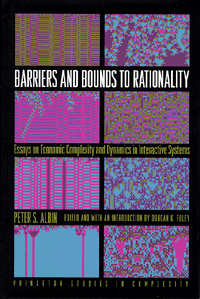Reviewed by
Roger A. McCain
Department of Economics, Drexel University, Philadelphia, PA 19104, USA.

Peter Albin's recent collection of articles on complexity and simulation in economics will be important to economists and other social (and computer) scientists with an interest in both computational interpretations and simulations of social phenomena, especially where spatial effects are important. Albin's ideas extend the limits of economics in ways that will often be of interest to other social scientists. For example, his discussion of rationality in terms of computational undecidability (p. 83) goes well beyond the usual dichotomy of bounded versus neoclassical rationality. Similarly, the simulation of alternative monetary policy rules shows that seemingly innocent changes can switch an economic system from regular to chaotic dynamics. This goes well beyond the dichotomy of rational versus adaptive expectations in economics, and puts concepts of chaos and complex dynamics to non trivial use in macroeconomics. In short, this is a book to challenge the preconceptions of economists, simulators and others.
Duncan Foley is the editor for the volume and one of the editors for the series (Princeton Studies in Complexity) in which it appears. However, Foley's contribution to the book is too major to be left at that. His seventy page introduction to the book is a useful primer of concepts in linguistic complexity that would stand on its own as a major interpretative essay. In addition, Foley is the co-author of Chapter 5: "Decentralized, Dispersed Exchange without an Auctioneer: A Simulation Study". This co-authored essay would be an ideal introduction to computer simulation for the first-year graduate student in economics. Non-economists may be puzzled by economists' focus on auction markets, but this reflects the key simplifying assumption of so much economic theory: real world markets function "as if" they were auction markets. Because of the interest deriving from that simplifying assumption, any first-year economics graduate student will find this study of interest. The assumptions highlight potential advantages of computer simulation: agents need not be perfectly rational, but their decision rules can be quite complicated; advertising plays a part; the simulated trading process leads toward the efficient allocation of resources, thus at least partly supporting the traditional simplifying assumption that decentralised markets function "as if" they were auction markets. At the same time, a key difference from auction markets is also verified: "mistakes" in trading lead to increases in the inequality of wealth. Finally, the essay reports comparative simulations in which the parameters are varied. Once again, this illustrates a powerful advantage of computer simulation - and once again the results are what our first year graduate student would expect: when advertising is more costly, there is less trade and the convergence toward an efficient allocation of resources is less pronounced.
Peter Albin has long been an advocate of the use of cellular automata (CA) in economic research (Albin 1975), and the three simulation essays in this book draw on line automata and work by Wolfram (1994). For line automata, it is possible to display the entire evolution of a simple automaton as a two dimensional diagram and these diagrams display different degrees of complexity in the resulting dynamics. These essays run the gamut of economic topics from pollution and congestion effects and monetary policy to trade to the multi-player Prisoner's Dilemma. A distinguishing assumption they share is that space matters, in that agents interact more intensely with near neighbours than with those further away. Given the growing recognition of the importance of space in real-world trade (Krugman 1995), these simulations should be of very wide interest in economics.
The non simulation essays focus on the computational interpretation of economic phenomena. Linguistic complexity theory and undecidability propositions are brought to bear on the possibility of economic forecasting and of consistent social welfare judgments. In the last chapter, directed graph theory is used as the basis for measurement of the complexity of organisations.
In summary, I believe this book has much to offer any "computational social scientist." It is a distinctive offering from a unique and invaluable mind.
ALBIN P. S. 1975. The Analysis of Complex Socioeconomic Systems, Lexington Books, Lexington, MA.
KRUGMAN P. 1995. Development, Geography, and Economic Theory, The M.I.T. Press, Cambridge, MA.
WOLFRAM S. 1994. Cellular Automata and Complexity, Addison-Wesley, Reading, MA.
Return to Contents
of this issue
© Copyright Journal of Artificial Societies and Social Simulation, 1999